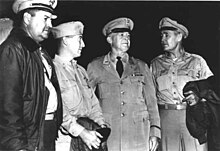Barney McKinney Giles | |
|---|---|
 Barney Giles (far right) with fellow air generals Curtis LeMay, Emmett O'Donnell and "Hap" Arnold (in tie) | |
| Born | September 13, 1892 Mineola, Texas |
| Died | May 6, 1984 (aged 91) San Antonio, Texas |
| Place of burial | |
| Allegiance | |
| Service/ | |
| Years of service | 1917–1946 |
| Rank | |
| Commands | Fourth Air Force Twentieth Air Force |
| Battles/wars | World War I World War II |
| Awards | Distinguished Service Medal (2)[2] Distinguished Flying Cross Air Medal (3) Navy Distinguished Service Medal Knight Commander of the Order of the British Empire (UK) Order of the Cloud and Banner (ROC) Mexican Medal of Military Merit |
Barney McKinney Giles (September 13, 1892[3] – May 6, 1984) was an American military officer who helped develop strategic bombing theory and practice. Giles stepped outside established bomber doctrine during World War II to develop long-range capabilities for fighter aircraft[4] in use by the United States Army Air Forces. Giles served as commanding general of the Fourth Air Force then as commander of the Twentieth Air Force in the Pacific Ocean Areas. In 1945 Giles was appointed honorary Knight Commander of the Order of the British Empire by King George VI of the United Kingdom.[4]
- ^ Cite error: The named reference
Texaswas invoked but never defined (see the help page). - ^ Official Army Register, 1946. Page 255. "Giles, Barney McK." (O10828) Retrieved on November 21, 2009.
- ^ Fogerty, Robert P. (1953). "Biographical Data on Air Force General Officers, 1917-1952, Volume 1 – A thru L" (PDF). Air Force Historical Research Agency. pp. 654–656. USAF historical studies: no. 91. Archived (PDF) from the original on August 31, 2021. Retrieved November 9, 2021.
- ^ a b The New York Times, May 10, 1984. Barney M. Giles, 91; Was Air Force Leader. Retrieved on June 6, 2009.
